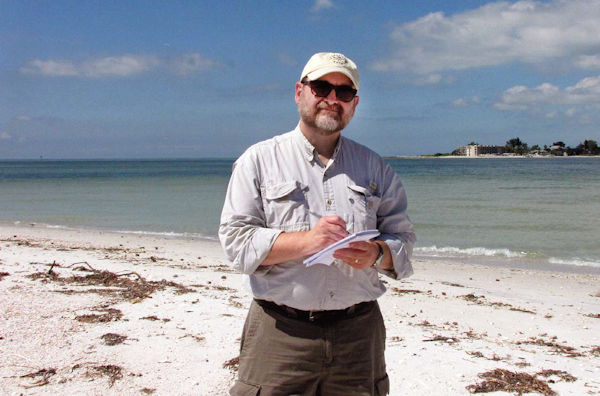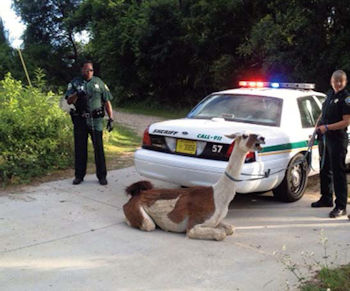SEJournal Online is the digital news magazine of the Society of Environmental Journalists. Learn more about SEJournal Online, including submission, subscription and advertising information.
Between the Lines
Author and Tampa Bay Times environmental writer Craig Pittman, in addition to his usual output of outstanding environmental stories and books, has found new ways to embrace the irregular, the weird and the wacky.
An SEJ member who began covering the environment in 1998, Pittman this year began writing a humor column about Florida for his newspaper. His latest book reflects that perspective. “Oh Florida! How America’s Weirdest State Influences the Rest of the Country” (St. Martin’s Press), which recently made the best-seller list for travel books on The New York Times, offers a humorous take on the state’s environment, crime and other issues, warning readers tongue-in-cheek that Florida is trying to kill us with hurricanes, sinkholes, sharks, alligators, mosquitoes, lightning, sandspurs and sea level rise. But that’s understandable, Pittman muses. “After all,”he says, “look at what we’ve been doing to Florida.”
For the latest installment of SEJournal’s author Q & A longtime educator, SEJ member and SEJournal Editorial Board member JoAnn M. Valenti interviewed Pittman about his new book, about covering the environment in Florida, about the book-writing process and balancing writing and journalism.
 |
| Tampa Bay Times environmental writer Craig Pittman at work on Shell Key, near St. Petersburg, Fla. Covering the beat since 1998, he declares, “I’ve almost got the hang of it.” Photo: Courtesy of Craig Pittman |
SEJournal: How does your deep personal knowledge of a place affect your environmental reporting?
Craig Pittman: Being from here gives me the context for alot of stories that other reporters might miss. For example, if I’m reporting on a story from the Florida Panhandle area where I grew up, I generally know the terrain, the people, their families and all the background before I even get started. If I’m doing a story elsewhere in the state, I’ve usually been there before and already know a lot about the place and about what’s gone on there in the past — enough to ask a lot of the right questions when I’m reporting.
Editors love that in a reporter. Sometimes, because of my knowledge of Florida history, my editors will ask me to provide the context on stories that aren’t on my beat, just because they know readers are impressed with having that much depth. I’m now writing a once-a-month column about Florida for our newspaper’s magazine.
SEJournal: Does having been on your state’s largest major daily for so long make it more difficult to keep stories fresh?
Pittman: Sure. In Florida, stories tend to repeat over and over, because the people in charge — no matter what party they’re in — are really good at kicking the can down the road. So I have to keep going back at stories, and reminding the readers that, ‘Hey, this isn’t the first time this issue has occurred, and nobody’s had the guts to fix it yet.’ Reminding people that things haven’t been fixed makes it an even more interesting story.
SEJournal: There’s a wealth of history in your new book, I assume reflecting your earlier life as a criminal courts reporter and familiarity with Florida’s wonderful Sunshine Law opening police logs. When and why did you move over to cover environment?
Pittman: After working at two other papers, I started at the Times in 1989 in a bureau where I covered a couple of small towns and a fast-growing unincorporated area. In 1994, I was promoted to the courts beat, which was good training because every issue in America eventually winds up in court. The courts beat has a lot of built-in drama and unintentional comedy, so it was fun to cover.
But my goal was to get to the environment beat. After all, how many jobs are there where you get paid to ride around in a boat, tromp through a swamp or hike through a forest? Also, my wife and I had our two kids and I couldn’t stay out until 2:00 a.m. babysitting a jury any more. So I was fortunate enough to land the environment beat in 1998 and I’ve been there ever since. I’ve almost got the hang of it.
SEJournal: I have to ask, given how much you know about Florida’s past and ongoing environmental demise, how do you sleep at night and why on Earth do you stay?
Pittman: (Laughs.) Well, most of it I just laugh about, because what else can you do? But knowing the history of Florida, I know that a lot of schemes to alter this state have come to naught, and nature has bounced back pretty strongly each time.
We go through cycles of boom and bust here, and usually once the boom is over, all that’s left are some fancy subdivision entrance gates that wind up being covered in vines. Besides, environmental crises tend to stir up alarmed people like Marjory Stoneman Douglas, turning them into activists and far more interesting people for us reporters. Florida’s been very influential on the environmental movement. For instance, Teddy Roosevelt designated the first national wildlife refuge here in Florida; the first environmental impact statement was written here; and a guy who grew up in Florida, Nat Reed, was co-author of the Endangered Species Act.
SEJournal: The horrendous murder of 49 people at the Pulse nightclub in Orlando and the death of a 2-year-old Disney tourist caused by an alligator occurred after your book had long gone to press. Would they have changed or added to the book?
Pittman: Both of those tragedies would have fit perfectly in the book because they’re the end result of things that I had already described. There’s a chapter on our obsession with guns, and that’s where the Pulse shooting would fit in. There’s another chapter that talks about the history of Disney, so that’s the logical place for that story of a sad event at the Happiest Place in the World.
The thing is, so much news happens here that I could write a new book like this every year with all-new material. But as a writer, you have to stop somewhere, usually around the time the editor is screaming at you to turn in the manuscript already.
SEJournal: How do you juggle covering your beat, making time for your family activities and writing books? And how different is it writing for a newspaper versus writing a book?
 |
| Leon County sheriff's deputies tasered a runaway llama in 2013. Photo: Leon County Sheriff’s Office |
Pittman: We’ve all got free time that we use up without realizing it — watching TV, playing games and so forth. It’s like whittling. It may be restful but it’s not earning you a dime, either. When my paper froze salaries several years ago, I started putting that time to use freelancing stories for magazines, generally writing in the morning after the kids headed off to school and at night after they’d gone to bed.
Then the folks at the University Press of Florida expressed an interest in turning one of my newspaper projects into a book, and that led to a new way to supplement my main salary. I outline my book first, then outline the chapters, then set myself a schedule for knocking out each chapter one by one as if they were weekend stories for the newspaper.
Any veteran journalist can write 17 or 18 weekenders over seven or eight months. That’s pretty much a book right there. When you set a schedule, it inspires you to make use of every bit of down time you get. My kids have been very active in Boy Scouts, and so I’ve taken a laptop along and gotten a lot of writing done on Boy Scout campouts and at summer camps when I wasn’t busy with the kids.
The difference between writing for a newspaper and writing a book is that you have a lot more freedom in a book to stretch out, try new approaches, maybe be a little snarky or silly. Then when you go back to doing journalism, that experience makes you a better writer. You’ve got some more tools in your toolbox that you feel comfortable using.
SEJournal: Miami’s bestselling journalist/author Carl Hiaasen calls the book “hilarious, creepy and sobering.” What’s next? Another book in the making between non-stop daily environment reporting?
Pittman: I have started fiddling around with the next book idea. It’s one that’s back on the environmental beat. To me it’s sort of the ultimate Florida environmental story. But I’m not ready to talk about it yet.
Pittman is also author of “The Scent of Scandal: Greed, Betrayal, and the World’s Most Beautiful Orchid” (2012), “Manatee Insanity: Inside the War over Florida’s Most Famous Endangered Species” (2010) and is co-author of “Paving Paradise: Florida’s Vanishing Wetlands and the Failure of No Net Loss” (2009).
* From the Fall 2016 SEJournal.













 Advertisement
Advertisement 



